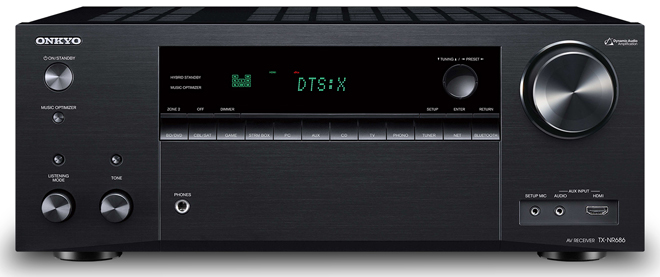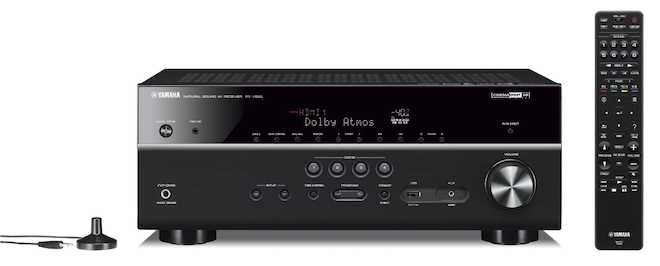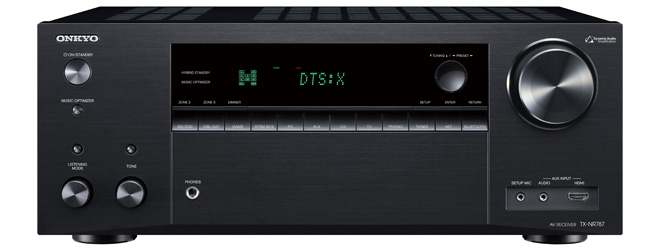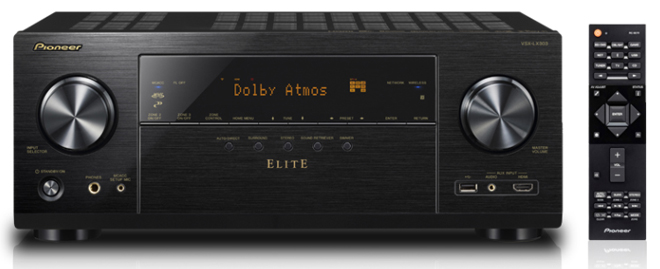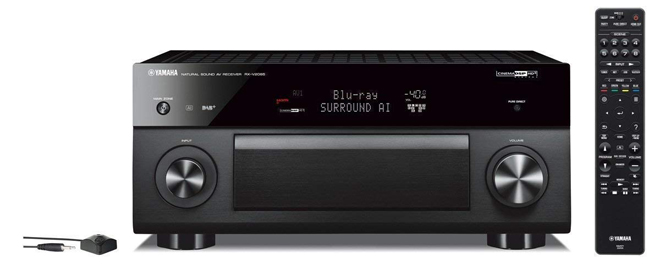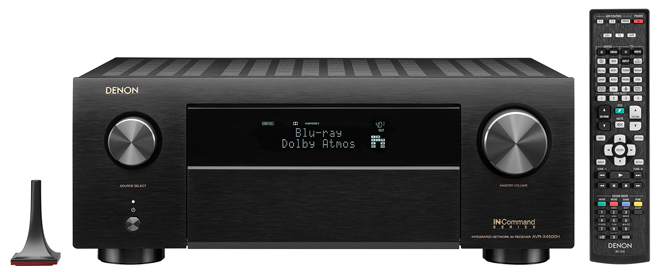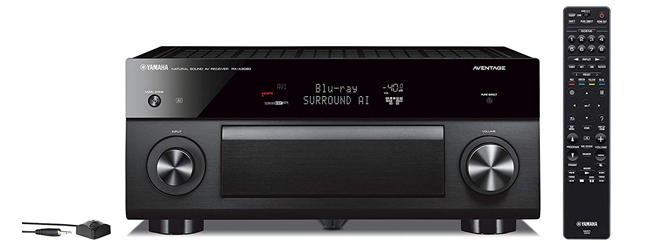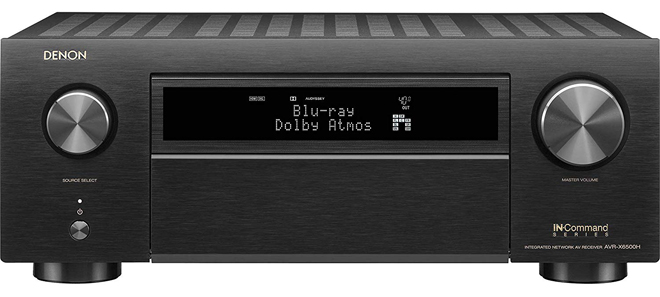Best AV receivers 2024: top sound for your home theater Digital Trends Whether you’re starting your first home theater or making upgrades, a solid receiver is one of your most important components. Here are several we recommend. By Michael Bizzaco Updated February 3, 2024 The best well-rounded AV receiver Pros - Excellent features for music as well as movies Supports up to 11.2 surround sound Support for Dolby Atmos, DTS:X, HDR, and many other formats 8K video support 140W per channel Cons - May be too much for those looking for something simpler

Whether you’re starting your first home theater or making upgrades, a solid receiver is one of your most important components. Here are several we recommend. By Michael Bizzaco Updated February 3, 2024
The best well-rounded AV receiver
Pros - Excellent features for music as well as movies
- Supports up to 11.2 surround sound
- Support for Dolby Atmos, DTS:X, HDR, and many other formats
- 8K video support
- 140W per channel
Cons - May be too much for those looking for something simpler
This is a pricey option, but Marantz made sure to improve upon past AV receivers by covering otherwise empty bases from prior models. The SR8015 is equipped with an array of AV technologies to make it fit in any home theater environment. Starting with all things audio, it’s got Dolby Atmos, DTS:X, DTS:X Pro, IMAX Enhanced, Auro 3D, plus the ability to connect a turntable for some vinyl playback or to stream from the likes of Spotify, Tidal, Pandora, and via AirPlay 2 devices, among others. You also get access to Alexa, Google Assistant, and Siri, plus the ability to do multiroom setups through HEOS.
It’s compatible with hi-res audio files and lossless formats that go up to 24-bit/192 kHz, and you can stream them to the receiver from a USB or network storage drive. The 11.2 channel system can run in 7.2.4 or 9.2.2 configurations when using all the channels. You can also keep some free-to-play music in different zones, where you get up to two extra. There are 140 watts of output per channel, so Marantz built the SR8015 to handle just about any speaker arrangement you have in mind. The Audyssey MultEQ XT32 support only helps the cause further with its room-correction technology to compensate for acoustics inside.
On the video front, the SR8015 is no less capable. It brings in 8K video at 60Hz (including upscaling) to go with 4K/120Hz, HDR (HDR10, HDR10+, HLG, Dynamic HDR, Dolby Vision), and HDMI-eARC that lets you pass full resolution surround sound from your TV through to the receiver. There are 8 HDMI inputs, plus 3 outputs, including useful add-ons like a Variable Refresh Rate (VRR) and Auto Low Latency Mode (ALLM) to accommodate gamers who need them.
There’s a lot to work with here because Marantz left little to chance, and that bodes well for how long this receiver may last in the years to come.
Marantz SR8015 The best well-rounded AV receiver More Amazon
Denon AVR-S770H
The best all-rounder for digital and vinyl heads
Pros - Dedicated phono preamp
- Six HDMI 2.1 inputs and 8K/60Hz eARC output
- Works with Alexa and Google Assistant
- Hi-res playback up to 24-bit/192kHz
Cons - No dedicated inputs for Zone 2
- Not as powerful as higher-priced receivers
Analog components are experiencing a big resurgence. If you’re the proud owner of a record player, but you also have a ton of digital components to wire up, we recommend the Denon AVR-S770H. A 7.2 x 75 watts per channel setup, the S770H includes a dedicated phono preamp for connecting a turntable. That’s on top of six HDMI 2.1 inputs, an eARC output (up to 8K/60Hz), Bluetooth and Wi-Fi connectivity, along with Alexa and Google Assistant compatibility.
When it comes to HDR and surround decoding, the S770H is one of the best options for less than $1,000. Supported formats include Dolby Atmos and DTS:X, as well as HDR10, HDR10+, and Dolby Vision HDR. While Wi-Fi isn’t required, connecting the S770H to the internet will also give you access to several music-streaming platforms, including Spotify, Tidal, Pandora, and SiriusXM. You’ll also be able to download the Denon HEOS app (for iOS and Android) to curate music, adjust receiver settings, and more.
If you’d like to add speakers to a second room of your home, the S770H can also be used as a dual-zone receiver. If you’re buying a receiver for Atmos or DTS:X, do keep in mind that the S770H uses either the Surround Back or height channels to power Zone 2. This means you won’t be able to run a full 7.1 configuration in Zone 1 (so no Atmos).
Last but not least, the S770H also supports hi-res music playback up to 24-bit/192kHz. While a higher-priced AV receiver will deliver even more ports and power, the Denon AVR-S770H offers a great combination of digital and analog connections for under $700.
Denon AVR-S770H The best all-rounder for digital and vinyl heads Related - Best Buy Prime Big Deal Days 2024: There are still some great deals
- Best soundbars of 2024: a sound upgrade for your TV
- The best short throw and ultra short throw projectors for 2024
Image used with permission by copyright holder
Sony STR-DH590
The best budget AV receiver
Pros - Affordable without giving up important features
- Pure Direct audio enhancement mode
- HDR support
- 4K support
Cons - Limited number of HDMI ports
When it comes to AV receivers, reducing your budget invariably means reducing the number of features. The key is to preserve as many of the features that most people value. The Sony STR-DH590 manages to do this in a stellar fashion by supporting all of the latest audio and video formats, including 4K and HDR (HDR10, HLG, and Dolby Vision). It also comes with its own acoustic calibration circuitry, which takes the guesswork out of setting up your speakers to the right levels.
For utmost audio fidelity, the DH590 is equipped with Sony’s Pure Direct mode for the cleanest sound the receiver has to offer. It does so by disabling the DH590’s front display panel, eliminating unnecessary component noise from escaping into the mix of whatever content you’re consuming. Keep in mind that engaging Pure Direct also bypasses several of the receiver’s internal equalizers. It’s a great feature for listening to music through analog sources, but if you’re a fan of big cinema sound, it’s probably something we’d leave alone when watching a movie.
Although the DH590 has Bluetooth for direct music streaming from a compatible smartphone or tablet, the receiver isn’t internet-connected, so you won’t be able to stream music without a Bluetooth device. That being said, Sony’s high-res audio support kicks in when you’re beaming tunes to the receiver, which adds a little more belly and top-end to your sound.
In terms of main source connections, the Sony STR-DH590 only has four HDMI inputs. While you won’t be powering any rock concerts, it’s more than enough receiver for a very satisfying home theater experience.
Sony STR-DH590 The best budget AV receiver More Yamaha
Yamaha Aventage RX-A2A
Best receiver for format support
Pros - Excellent format and file support
- Vibration dampening
- Seven HDMI ports, including support for HDMI 2.1
- 5.1 wireless surround sound support
Cons - A bit more focused on audio than video
The 7.2 Aventage RX-A2A is more than capable as a powerhouse video system. Naturally, it has support for all of the latest AV technologies: 4K, HDR (HDR10, HLG, HDR10+, etc.), Dolby Atmos, DTS:X, and HDCP 2.3. It’s also ready for HDMI-eARC and is compatible with hi-res audio files up to 32-bit/192 kHz.
HDMI 2.1 is also supported if you like to stay on the cutting edge of AV support for your entertainment system, and future updates will add support for things like 8K and the latest formats. Inside, you’ll find features like a high slew rate amplifier for more accurate audio response and low distortion, as well as advanced modes for movie optimization. Outside, the design includes an A.R.T. (Anti-Resonance Technology) wedge to help dampen nearby vibration and improve audio quality further. MusicCast features wireless 5.1 surround sound support also help if you like to play music on the system as well.
Don’t worry about a lack of connections, either. The Yamaha Aventage RX-A2A includes seven HDMI input options to handle any devices you may want to set up. There’s even compatibility with Alexa and Google Assistant when you can’t find the remote.
Yamaha Aventage RX-A2A Best receiver for format support More Denon
Denon AVR-A1H
Best high-end AV receiver
Pros - 15.4 channels with 150 watts per speaker
- The latest video and audio formats
- Game-friendly capabilities
- HEOS support for wireless setups
- Voice assistant compatibility
Cons - May be too expensive for some home theaters
Denon’s upcoming high-end AV receiver packs every possible feature inside and is ready for years of channeling top-tier content for your system. The receiver, rated at 150 watts per channel, supports up to 15.4 channel setups for a variety of configurations for the best possible sound in your home theater.
While it’s probably easier to list what the AVR-A1H doesn’t support, here’s some of what it does: 8K resolution is a given, along with the latest DTS formats like DTS: X and DTS HD Master. Dolby TrueHD and Dolby Atmos support are included, as is IMAX Enhanced, Auro 3D, 360 Reality Audio, and much more. HDR, HLF, Dolby Vision, HDR10+, and other formats are supported for visual optimization, too. It also offers HEOS compatibility for wireless multiroom setups, while gamers will appreciate compatibility with Variable Refresh Rate (VRR) and Auto Low Latency Mode (ALLM ). And like our Denon pick above, it also has a phono input to get your vinyl on.
There are seven HDMI in and three HDMI out ports to handle your entertainment system, along with 17 speaker terminals, four subwoofer out ports, USB, and more. Helpful modes allow you to do everything from sync bass to set a sleep timer or enter an ECO mode to save energy.
Of course, it’s expensive at $6,500, easily the highest price tag on our list. You’ll have to pay to get this much support and connection options, and not everyone will need it. But it’s ready to coordinate your home theater for the long haul and will deal with anything you throw at it, making it an easy recommendation for the best high-end option for massive-sized setups.
Denon AVR-A1H Best high-end AV receiver More Image used with permission by copyright holder
Denon AVR-X4800H
Best AV receiver for 8K
Pros - 8K ready, along with many other formats
- Great gaming support
- Varied connection support, including HDMI, composite, digital, and more
- New computer-based calibration technology
Cons - Not everyone is interested in preparing for 8K yet
The above-mentioned Denon AVR-A1H, at over $6,000, is certainly not for everyone. But you can trim that price down a whole lot if you’re only interested in future-proofing a few key features in a slightly smaller setup while still getting an incredible amount of support. The Denon AVR-X4800H does just that, offering 8K support (plus upscaling) on all seven HDMI inputs and two of the three HDMI outputs. That also goes for game-friendly technology like VRR, ALLM, and QFT.
Outputs support up to nine simultaneous speakers or 11 channels in all, at 125W each, including four subwoofer outputs. There’s support for Dolby Atmos Height Virtualization, IMAX Enhanced, DTS, Auro-3D, HEOS, direction connections like AirPlay 2, HDR 10+, and HLG, as well as 3D signal passthrough.
And if you have older connections to manage, there are also component and composite video inputs, five analog stereo RCA inputs, optical and coaxial digital inputs, plus phono. That’s a great recipe for longevity as you eventually upgrade your HDTV and other devices to the latest and greatest home theater tech. It even works with Alexa and Google Assistant for voice commands over things like volume and skipping tracks.
You’ll also have the ability to download an advanced speaker calibration program to PC or Mac and use it to minutely adjust your sound based on your own unique space. There are few other options so well-suited to bridging the past and the future as the AVR-X4800H, especially if you don’t mind planning on some serious investment in 8K and related formats.
Denon AVR-X4800H Best AV receiver for 8K More Marantz / Marantz
Marantz Cinema 70s
Best sleek and compact AV receiver
Pros - Slim design
- Excellent HDR and surround codec support
- Six HDMI 2.1 inputs and 8K/60Hz eARC output
Cons - Not as powerful as other models
- Pricey
If you need an AV receiver but can’t stand the idea of a bulky piece of hardware, the Marantz Cinema 70s is an excellent alternative to big, boxy, and square. This 7.2 receiver may not be as powerful as some of the other models on our list (50 watts per channel), but in this case, less amplification translates to a slimmer product. Part of Marantz’s slimline family, the Cinema 70s is just over 4 inches tall.
Not only will the Cinema 70s look great in your entertainment center or AV rack, but it’s also got plenty of ports. This includes six HDMI 2.1 inputs, an eARC output (up to 8K/60Hz), USB, Bluetooth, and several other digital and analog connections. When connected to the internet, you’ll also be able to access music-streaming platforms like Spotify, Tidal, SiriusXM, and Pandora (HEOS app required).
The Cinema 70s is no straggler when it comes to hi-res playback either: With its PCM 24-bit/192kHz cap, you’ll be able to listen to detail-rich tracks and albums, making a Tidal subscription all the more alluring. That’s on top of next-level support for the leading picture and sound formats of today, including HDR10+, Dolby Vision, Dolby Atmos, and DTS:X.
The Cinema 70s even includes a powered second zone. Opting for this configuration will prevent you from being able to wire up a full Atmos system though. Zone 2 can borrow audio sources from Zone 1, but the receiver also supports dedicated sources for a second listening area, including analog inputs, USB, Bluetooth, and HEOS streaming services.
Marantz Cinema 70s Best sleek and compact AV receiver More Onkyo
Onkyo TX-NR5100
Best mid-range AV model
Pros - Great support for current standards and voice assistants
- Gamer-friendly optimization
- Good features for mid-range price
Cons - No 8K support
- Wattage is low compared to high-end picks
Those who want support for the latest features and standards while still staying at mid-range prices will find a lot to love about this Onkyo model, which is also a great pick for gamers or those looking for an upgrade to their movie experience.
This seven-channel receiver offers 80 watts per channel into 8 ohms at 0.08% THD (Total Harmonic Distortion) with two channels driven. Connections include four HDMI 2.1 ports in and two out (with HDCP 2.3 support), optical, coaxial, stereo RCA ports, USB ports, and dual subwoofer RCA ports, plus a headphone jack when gaming sessions need to stay quiet.
When we dig into more supported standards, this Onkyo model gets even more impressive: It’s compatible with Dolby Atmos and DTS:X processing, Sonos Port, AirPlay 2, Bluetooth, Chromecast, Alexa, and Google Assistant. There’s built-in Wi-Fi and compatibility with ARC/eARC, too. HDR10+, Dolby Vision, and HLG (Hybrid Log-Gamma) are also all supported, making this receiver very well-rounded for all kinds of optimization.
Like some of our other picks, the Onkyo TX-NR5100 also has a few features dedicated to gamers, including Variable Refresh Rate (VRR), Auto Low Latency Mode (ALLM), and Quick Frame Transport (QFT), which can help improve frame rate performance and cut down on issues relating to lag.
Onkyo TX-NR5100 Best mid-range AV model More
Frequently Asked Questions
Are some AV receivers better for music than movies?No. Most receivers do very well for movies as well as music, with performance scaling up in tandem as you move into premium models. However, music can be more revealing of sound quality and character than movie soundtracks, and those who value music listening may find one brand more sonically satisfying than another.
Additionally, if music is is your main focus, you may want to consider just getting a stereo receiver or integrated amplifier instead.
Do all AV receivers support 4K? What about 8K?All of the models we highlight support 4K and most also support HDR formats as well. These days, only particularly old receivers will lack 4K support.
While 8K is available in some form or another today, the technology is still new and rarely seen outside of some specialized broadcasts. However, as it becomes more common, we are seeing 8K support show up in more places, including several of our top receiver picks. Consider it a future-proofing option as 8K continues to appear more frequently.
Can I easily use an AV receiver with a turntable?As long as it has a phono input, yes. If not, you’ll need a phono preamp to boost the usually-low signal from the turntable. Preamps can be quite affordable for entry-level models.
What external devices do you need to buy to connect to your receiver?It’s helpful to think about this in terms of inputs and outputs. What devices do you want to input audio and video, and what components do you want that audio and video delivered to? The second question is answered automatically with an AV receiver: You’ll be outputting audio to speakers (which often come with many receiver packages) and video to a TV or similar display.
For inputs, that largely depends on what you have and what you want. You can connect consoles, Blu-ray players, laptops or PCs, set-top boxes, and a variety of other devices to a receiver. You will want to pay close attention to the ports on your devices and make sure your receiver supports the most effective way to receive AV data, such as eARC. There’s a lot more to discuss about the different types of setups an AV receiver can support, but this will help you get started.
What is the difference between an AV receiver and an amplifier?Simply put, a receiver component can receive and process an audio signal, while an amplifier component optimizes the audio signal and sends it on to the speakers. AV receivers include both, so that’s not something you generally need to worry about. Some types of speakers do have their own amplifiers included but will need a receiver device to work.
How can you tell a good AV receiver from a bad one?That’s a complicated question, depending on a myriad of factors like format support, connection standards, hardware components, processing technology, and a lot more.
For some time, the rate at which features were being added made buying any AV receiver a risky proposition if you didn’t want to be stuck with something that quickly went out of date. With 4K, HDR, HDMI, and HDCP seemingly having everything worked out for the 4K era, it’s much safer to buy a receiver now without worrying that you’ll quickly see the future pass you by. Dolby Atmos and DTS:X seem entrenched as the two major leaders in object-based surround sound
If you really want to dive in, one of the best places to start is our guide to everything you should know when buying an AV receiver.
Is an AV receiver good for gaming?It can be, especially if you like gaming with surround sound for immersion. Look for support for all the latest standards before you buy, including Dolby Atmos, one of the newer HDMI standards like 2.0 or 2.1, and HDR compatibility. There are also features, like on our Denon AVR-X4700H pick, that add more benefits for gamers, like Variable Refresh Rate support and Auto Low Latency Mode. An AV receiver isn’t required for gaming, but it’s an important addition if you want true surround sound.
How do you test?Collectively, the AV team at Digital Trends has been testing AV receivers for just over 40 years. Testing takes place both in a dedicated home theater lab at our headquarters in Portland, Oregon, as well as in our individual home theater spaces. That spans a wide variety of sourcing equipment able to handle the latest standards.
Connected speakers include a rotating cast of speakers, including many Dolby Atmos-enabled models. While we routinely run any given receiver’s auto setup routine to gauge its accuracy and user experience, we ultimately perform a manual calibration using an analog SPL meter, carefully choosing crossover points for connected speakers based on in-room measured low-frequency response. Surround speaker arrangements will vary between 7.2 and 5.2.4.
Receivers are tested for ease of use, with special attention paid to how easy it is to stream music to the receiver as well as direct-stream internet radio stations. We also pay attention to how clear on-screen guides and setup instructions will be for novice users.
Sound quality tests include analysis of dynamic expression, overall power, timbre, and tonality; speaker-to-speaker transitions of sound effects; and general soundstage quality.
Is it bad to leave an AV receiver on all the time?It’s not the best habit, but it won’t do much harm. Today’s AV receivers are built to go into standby modes and use as little power as possible.
Does an AV receiver need ventilation?Ventilation is important to keep the receiver from overheating. For example, Denon recommends that you give its receivers at least five inches of space on the top and two inches on the sides. If the amp inside overheats, it may automatically shut off to protect itself.
How many channels should an AV receiver have?Since receivers can last a long time, it’s a good idea to get as many channels as you can so you have the option to upgrade to more surround sound in the future. We recommend at least a 7.1-channel system, even if you don’t currently use that many speakers.
Glossary
- 4K: Higher resolution than HD (3840 X 2160). The latest standard for TVs and AV receiver models, although some are even going up to 8K these days.
- Dolby Atmos: One of the two most popular object-based surround formats, Atmos adds height information so sound can seem to come from above and all around you.
- DSD: Direct-Stream Digital. A hi-res audio file format alternative to .WAV, .AIFF, and others that aims to reduce distortion.
- DTS:X: The other most popular object-based audio format, DTS:X can be more flexible than Dolby Atmos when it comes to where speakers are placed and how many of them there are.
- HDCP 2.2: A form of copy protection, this version is required in order to play 4K content.
- HDMI 2.0a: While it isn’t the newest version of HDMI, this version is the first that allows HDR signals and 4K content at up to 60 frames per second.
- HDMI 2.1: HDMI 2.1 supports higher frame rates and up to 8K resolution, among other improvements, and is the latest standard for AV connections.
- HDMI eARC: eARC — or “enhanced audio return channel” — is an upgrade to the standard HDMI ARC interface. The tech was designed to allow one-cable transmission of audio and information to and from the TV to simplify home theater setups, but the eARC upgrade also adds full support for hi-res surround sound formats.
- HDR: High Dynamic Range, offers better contrast and more color volume than standard dynamic range. Considered by some a bigger visual improvement than 4K resolution. Even if you want a stereo receiver, HDR is still an important perk for your image quality.
- VRR: Variable Refresh Rate. This technology can adjust the refresh rate of a display so it matches the output of a gaming console like an Xbox or PlayStation. If you have a newer console in your home theater, VRR on both your TV and receiver will help eliminate tearing and other problems.
- THD: Total Harmonic Distortion. This measurement is typically expressed as a percentage, such as 0.008%. It shows how much harmonic distortion is created by devices like receivers. Lower THD is better for audio accuracy, and high-quality receivers will have low THD numbers.
- Denon HEOS: Denon Home Entertainment Operating System. This was originally a wireless standard offered by Denon to support wireless audio connections between speakers in different rooms. It has developed into a platform now known as “Denon Home” but HEOS devices are still compatible with it and Denon Home still works with the HEOS app.
- HLG: Hybrid Log Gamma. This is a signal used by some broadcasters to enable HDR optimization more efficiently. It combines HDR and SDR coding into a signal that can be sent to any TV without worrying as much about compatibility.
- QFT: Quick Frame Transport. This technology increases the frame rate to help cut down on display latency, or those small delays between visual data being generated in a device and actually being displayed on your TV. It’s another technology that gamers will appreciate in a TV and accompanying receiver.
- ALLM: Auto Low Latency Mode. This mode detects when you are using a connected gaming device, and switches to a separate game mode to help optimize visual data and cut down on latency.
Editors’ Recommendations
-
Best projector deals: Replace your TV with a big screen from $58
-
The 8 best subwoofers for 2024: add boom to your movie or music room
-
Best cheap headphones and earbuds 2024: Earfun, Soundcore, Beats, and others
-
The best speakers for 2024: great hi-fi options for music and more
-
Best Bluetooth speakers for 2024: Beats, JBL, Soundcore, and more
-
Best projector deals: Replace your TV with a big screen from $58
-
The 8 best subwoofers for 2024: add boom to your movie or music room
-
Best cheap headphones and earbuds 2024: Earfun, Soundcore, Beats, and others
-
The best speakers for 2024: great hi-fi options for music and more
-
Best Bluetooth speakers for 2024: Beats, JBL, Soundcore, and more
While many modern turntables and devices include their own built-in phono preamps, getting your own can give you more control over your sound and even improve it byadding balance, stability, smoothness, clarity and even better sound staging. Certain preamps also include additional features, like the ability to switch between more common moving magnet (MM) phono cartridges and higher-end moving coil (MC) cartridges, should you be getting into more audiophile-level territory.
FAQ
Can AV do 4K?
In the world of audio-visual (AV) technology, amplifiers play a crucial role in delivering powerful and immersive sound experiences.٢٥/٠٧/٢٠٢٣
What is AV amplifier used for?
![]()
With A/V receivers, the basic functionality is to receive an audio signal, amplify the audio signal to drive multiple speakers, and allow pass-through of the corresponding video signal to a display device such as a projector or a television.
Does AV receiver improve video quality?
By providing a separate decoder for each type of video signal, an AV receiver can reduce the amount of noise and interference in the signal. As a result, it results in a cleaner, sharper picture. In addition, an AV receiver can provide enhanced features that can improve other video features of your system.31 Jul 2022
Who is Yuma Japanese actress?
![]()
Yuma Asami (Japanese: 麻美 ゆま, Hepburn: Asami Yuma; born March 24, 1987), is a Japanese actress, singer, and a former adult video (AV) actress and model.
What is an AV processor?
![]()
An AV processor preamplifier, also known as a preamp or a surround sound processor, is a device that provides audio and video processing and routing capabilities in a home theatre system. It is designed to work in tandem with an external power amplifier to deliver high-quality audio and video.

















 I’m a music producer and audiophile obsessed with the intricacies of the aural experience. With a trained ear that scrutinizes every sonic layer, I have been immersed in music my entire life.
I’m a music producer and audiophile obsessed with the intricacies of the aural experience. With a trained ear that scrutinizes every sonic layer, I have been immersed in music my entire life. Denon AVR-X2800H AV receiver | Image: Denon The AVR-X2800H offers a great blend of features and a sonic performance that’s hard to beat.
Denon AVR-X2800H AV receiver | Image: Denon The AVR-X2800H offers a great blend of features and a sonic performance that’s hard to beat. Yamaha RX-V4A AV receiver | Image: Yamaha The RX-V4A is a flexible and versatile option with exceptional wireless connectivity, offering seamless Bluetooth and Wi-Fi options that work exceptionally well for streaming from various platforms like Spotify, Tidal, Deezer, Qobuz, and many others.
Yamaha RX-V4A AV receiver | Image: Yamaha The RX-V4A is a flexible and versatile option with exceptional wireless connectivity, offering seamless Bluetooth and Wi-Fi options that work exceptionally well for streaming from various platforms like Spotify, Tidal, Deezer, Qobuz, and many others. Sony STR-AN1000 AV receiver | Image: Sony The STR-AN1000 delivers exceptional performance in both power and features, making it a great choice for home theater aficionados of all levels.
Sony STR-AN1000 AV receiver | Image: Sony The STR-AN1000 delivers exceptional performance in both power and features, making it a great choice for home theater aficionados of all levels. NAD T 778 AV receiver | Image: NAD Electronics The NAD T 778 is on the expensive side but delivers a top-notch sound that will leave you breathless.
NAD T 778 AV receiver | Image: NAD Electronics The NAD T 778 is on the expensive side but delivers a top-notch sound that will leave you breathless. Denon AVR-A1H AV receiver | Image: Denon The AVR-A1H is Denon’s flagship, and a force to be reckoned with: a powerhouse receiver with 15 channels, 150 watts per channel, delivering power and precision at any volume.
Denon AVR-A1H AV receiver | Image: Denon The AVR-A1H is Denon’s flagship, and a force to be reckoned with: a powerhouse receiver with 15 channels, 150 watts per channel, delivering power and precision at any volume.
